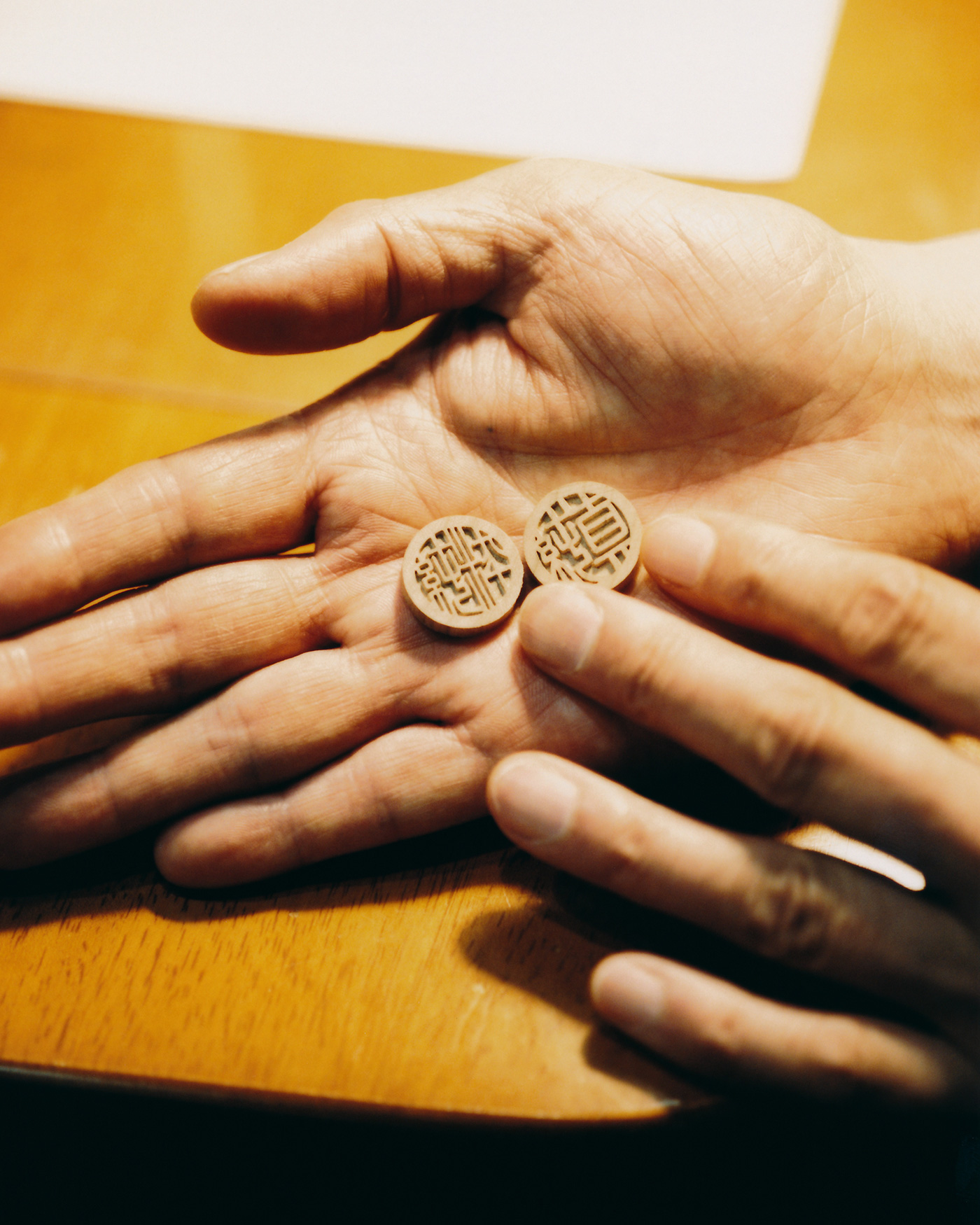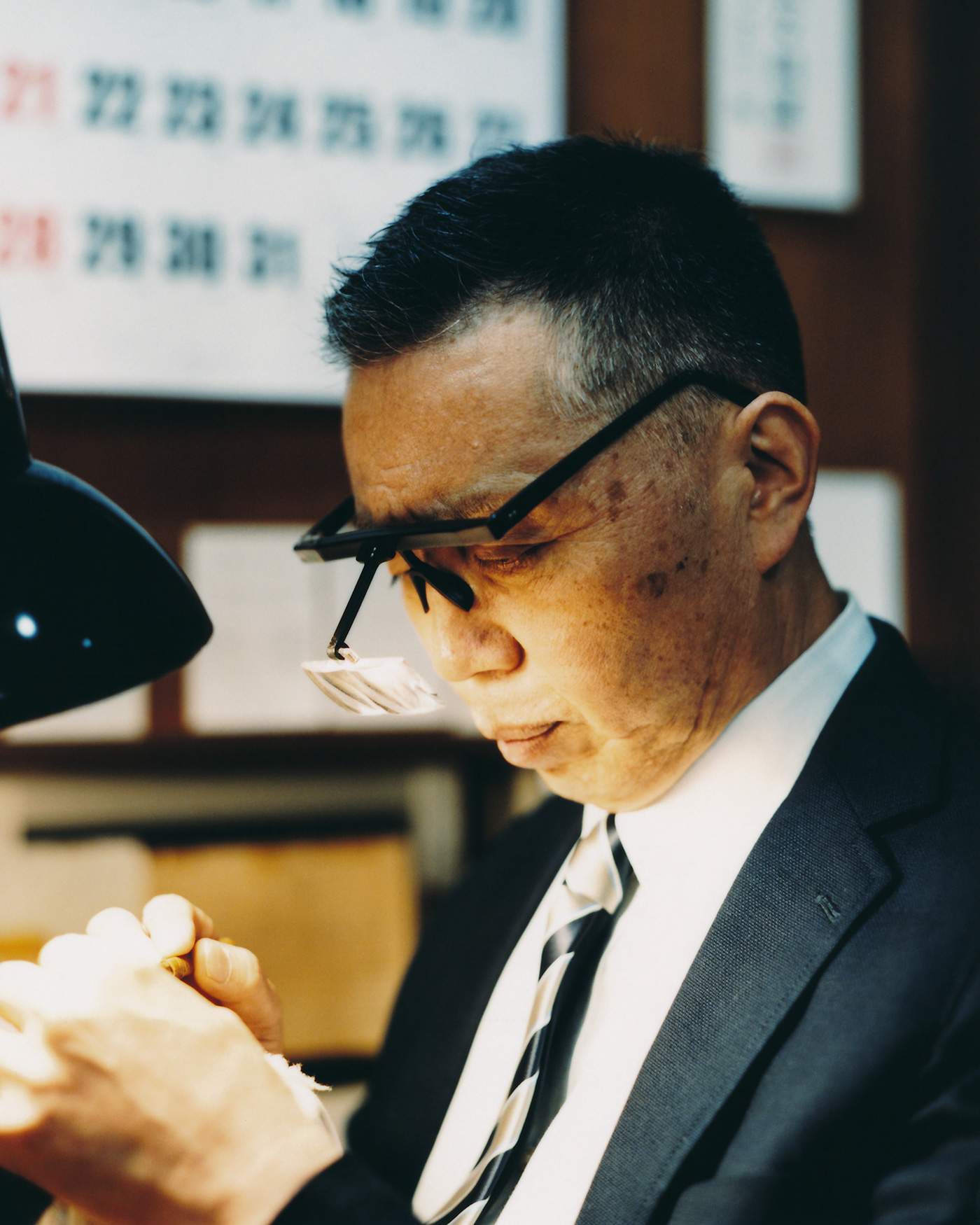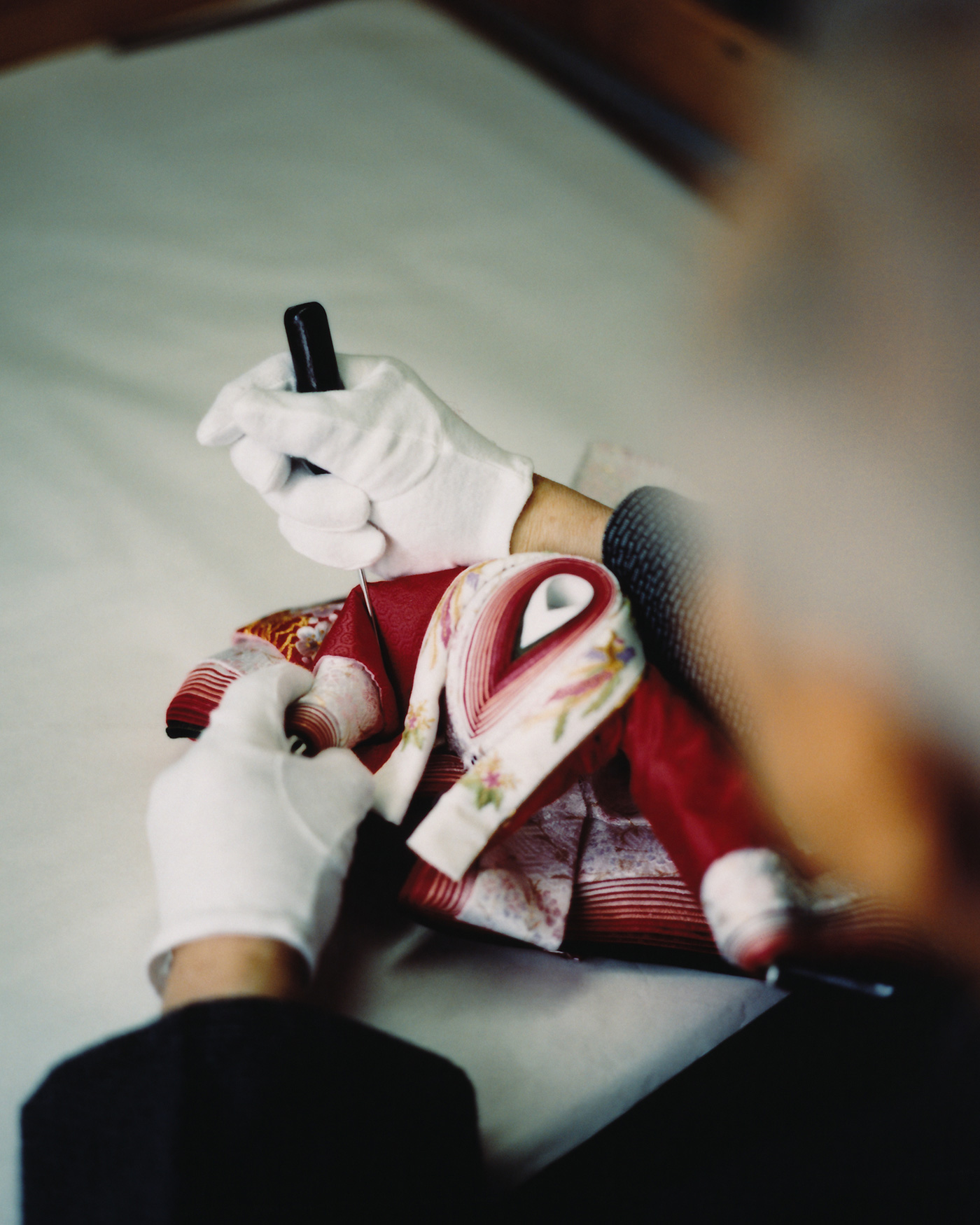So, it was during the Edo period that the profession of seal carver became widespread. How are the skills learned?
Practice starts with writing mirrored characters in a large size. Everything is written by brush. The size of the characters gets smaller and smaller. My father spent a great deal of time carving when he was an apprentice, doing one seal a day. The time varies by person, but a carver can do a pretty good job after about two years of training.
Fitting mirrored characters into that tiny circle is an amazing skill, isn’t it.
Yes, it is. It takes mastery to write the mirrored characters so they fit inside the circle with a pleasing balance. The rough sketch is called inko. My father seems to have been able to create this just from imagination. Apparently he was writing characters with a brush even before he started school, so he seemed to always like it, and I assume he gradually developed a good sense of balance. Just like a calligrapher, it’s necessary to learn about the Chinese characters themselves, to study how they’re formed.

Seals are a fine art, designed from characters alone inside a small circle.
Along with the difficulty of fitting characters inside the circle, different character styles complicate things. The basic characters are in the dictionary, but a single character can have several types of form. There are characters that have different shapes but that are considered to be the same character, and there are old forms of characters. The number of strokes and the shape of the characters differ slightly, so, as an example, if we’re putting four characters into a registered seal, we’d design it by considering which characters would go together well to create a good balance. Things get difficult again when hiragana characters are included. My father’s able to make quick decisions thanks to his years of experience, and is able to ask “how about this design?” right in front of the customer.
How does the finish of the seal differ between hand carving and machine carving?
Finishing all of the characters through hand carving allows the expression of dynamism. Expressing thick and thin strokes with good balance yields fine characters that seem to move with a life of their own. In the finish of the fine details, the carving knife is angled and the force is adjusted to match the material. This skill mastery maintains toughness that is able to resist chipping. The seal’s beauty and dynamism, and its sharpness when stamped, differ from those of machine-made seals. A hanko seal also has an outline. Making this as thin as possible allows the expression of a delicate beauty. With a machine, everything takes on the same thinness and the finish ends up monotonous.
There are Chinese characters with a lot of strokes and others with few strokes. Arranging these in a balanced way must be a tough task.
It is. By making characters a little larger or smaller, and otherwise refining their arrangement in the circle, we create designs with good balance. When there are few characters, like just one Chinese character, the design can be made complex. There are said to be 100,000 to 200,000 surnames in Japan, a diversity unusual in the world. In addition, the beauty of curves varies with the character style. These styles appeared one after another to make the characters as beautiful as possible and to indicate authority. Expressing the delicacy and strength of a character style calls for a high level of skill.

In the context of your history, what sort of significance is there for Sumire Dou in creating new products through this latest project?
Running the shop at Sumire Dou over the last six years, my love for traditional handicrafts and the handiwork of specialist artisans has grown. I’m not a skilled artisan myself, but I’ve searched all along for something I can do in the form of a communicator who transmits the thoughts of the creators. During that search, the artisan who made the Sumire Dou hanko seal cases for us said to me, “I think you should introduce your seals to people overseas.” I didn’t really get it then, but later I began to wonder what people overseas would think of handicrafts from Japan, and whether there were some opportunities for communicating their appeal. That’s when I learned about this project and decided to take part.
Right now, there’s a trend toward going without seals. Seeing how the character styles of seals are being applied to companies’ logos and signboards and put to use as designs, I feel that, even if it’s difficult for seals to continue on as seals, there’s potential for creating new value in some other form. My wish is that the creation of products that give young artisans bright hope will lead to more people taking this on in the future.
Amid the challenges, I also feel the value in having a lot of encounters and experiences. I expect that the potential for widening horizons and creating better things, and meeting different specialist crafters to join hands while combining people’s respective strengths, will broaden the possibilities for traditional handicrafts many times over.

In your collaborations with designers, have there been any new skills or ideas you’ve taken in, or changes in your perspective?
There are a lot. First, I met Furukawa, a designer living in Milan. From this designer, I’m learning the importance of researching how people live and what they are looking for overseas, and the importance of making things to fit overseas styles. I was told that, even if we brought over the Japanese hanko seals as they are, they wouldn’t match lifestyles and customs overseas, and it would be difficult to get people to feel their value as a traditional craft. My thinking has changed with the realization I have to think first about excitement, enthusiasm, being startled at my own sense.
So, before the matter of this being a traditional craft, what’s important is whether it’s compelling.
That’s right. If the product isn’t compelling in and of itself, it’s not going to sell. This wonderful thing, it’s actually a traditional craft. And it’s made in Japan! That’s what’s important. So by considering seal design and carving as a technology and making products for people overseas, we’ve created “seal jewelry.” Living in Japan, I never had the idea of turning seals into jewelry. My heart leapt when I first heard of it. It changed my perspective from “stamping” a seal to “wearing” one. It felt like my future had expanded. Wearing jewelry is certainly something that excites people around the world, so I hope to use this as an opportunity to take on different challenges. I was also able to connect with other artisans in the project, which was also a big win.

The product you’re announcing is a pendant. What processes go into making it?
We first purchase yamazakura wood and work it into round bars, which takes two weeks, then another week for slicing the bars, a week for seal design and carving, two months for applying black lacquer and gold powder, and one week for precious metalwork. With all of the processes combined, it takes about four months to go to finish.
In addition to seal design and carving, Sumire Dou also collaborates with artisans in woodworking, lacquering, and jewelry metalworking. Making the wooden parts was trial and error. I had a lot of back and forth with Furukawa on questions like how thin the bars can be sliced, and whether seal characters be carved on slices made as thin as possible.
We found that the thickness could be reduced bit by bit in 1mm increments, down to slices of 4mm. The round bar is the part at the top of the pendant, so we spent a lot of time deciding on the size and thickness. It’s through this checking that I learned how even a 1mm difference can make a huge difference in appearance.
You’re planning word selection and designs for use as gifts. What sort of techniques are you using?
For the words placed at the top of the pendant, we thought along the theme of words that would act as a talisman. There are 12 choices available for the words, so we offer something that people can feel embraces their thoughts when they wear it. We thought about a bunch of things for seal designs, such as delicate characters, boldly drawn characters with curved lines, and straight-line characters. We had the neighbors and acquaintances of Furukawa in Milan look at the designs and offer comments, which was really helpful. I thought about designs that accompanied the Japanese with English text, but was given advice that not having the English text is better, so I went back to the drawing board. For people overseas, seals with Chinese characters seem to look like pictures.
Unlike Japanese people, who view Chinese characters as words with meaning, they see them as art.
Yes, it is. A friend who lived in Canada told me about a person there who was proud of having a big tattoo of the two characters meaning “kitchen.” Two Chinese characters together look cool. The shape is nice. It really is art, isn’t it. In one sample, I used the two characters that make the word for “affection.” I also want people to treasure the talisman-like meaning behind the pendant, so I’ve had “LOVE” in English laser-engraved on the back.

You’ve collaborated using different craft techniques like lacquer and gold leaf. What sort of characteristics do the materials have?
The material for the top of the pendant is Japan-grown yamazakura wood, from the genus that contains cherry trees within the rose family. We considered all kinds of materials, including stone and crystal. I wondered about things like whether chipping would occur during cutting, and whether my father could do the carving. In the end, we went with wood as it offers the best compatibility. We chose yamazakura for its story potential as a tree only grown in Japan, its history as the wood considered optimal for ukiyo-e prints in the Edo period, and its popularity as a material for high-end furniture in Japan. Those were the reasons behind the selection.
For the gold in the pendant’s precious metalworking, we were told that people overseas prefer high-purity gold over plating, so we went with 18-carat. Balancing things with selling price was another worry. Trying to make something good would send the price beyond one million yen. That won’t sell, and so it isn’t realistic. After considering the best size that would draw out the beauty of the delicate seal, we decided to make the pendant top about 20mm.
Were there any troubles in finding artisans to collaborate with?
I expected the partner search to be tough, but when I talked with other project colleagues, I quickly got introductions and was able to find partners more easily than I’d expected.
Chiyodaya, a shop that took part in the first phase of the project, does the lacquering, and Iwata Sanbo Seisakusho, a company taking part in the second phase, makes the jewelry cases from cypress wood.
Do you find difficulties in production, different from your usual seal design and carving?
Normal seal design involves carving mirrored characters, The pendant top isn’t used as a stamp like a seal, though, so the characters have their normal orientation. That caused some confusion. It was a first for my father in his 42 years of experience, and apparently puzzled him a bit, but the carving itself works the same as usual. The work of thinly slicing the round bars and the lacquering seem to have been more troublesome.
About how many artisans are involved in making the product?
We’ve had seven members become involved.
The first was a woodworker in the Shinshu area, who procured the yamazakura wood and worked it into round bars. The second was a woodworker in Nishi-ku in Nagoya, whom we asked to make size alterations to the bars. The third was a furniture maker whom we asked to make Sumire Dou’s seal cases, which involved the challenge of making slices as thin as possible, a millimeter at a time. After that, my father came in as the fourth person in the project. A seal carver designed and engraved the seals, and we asked the fifth member, Chiyodaya, to apply the lacquer and gold powder. The 6th member, a jewelry crafter, performed the precious metalworking, and the 7th person, Iwata Sanbo, was in charge of crafting the packaging. The seal jewelry is created through a coalescing of the abilities of artisans from differing specialties.

What sort of vision do you have for this handiwork culture handed down for seven decades, and the transmission of techniques that machine carving is unable to express?
I take it as a given that the demand for seals as administrative necessities is waning. I think it’s important that we incorporate freer and more flexible sensibilities into the future transmission of seal techniques, and to work toward a shift in value. I myself have been involved in the development of two products: the seal set with original seal case developed by Sumire Dou, and the new seal jewelry. What I do is first clearly communicate what’s appealing about both of these. I want to do a lot of activities that will let customers know about the products.
In the project, learning about the shift in value from “stamping a seal” to “wearing characters” was a big thing for me. As far as jewelry goes, I think it’d be interesting to go beyond pendants and also into bracelets and earrings. I think there are endless possibilities.
It could be interesting to make the products a little more affordable so they can become souvenirs for overseas tourists, or to create tours for experiencing carving. Like calligraphers who work on company and store logos, billboards, movie titles, and so on, I think that the directions of seal designers, conveying the wishes inherent in characters as messengers of the characters’ appeal, will create hope for the future.

What meaning does making things by hand in our era hold for Sumire Dou?
I spoke about how the appeal of hand carving lies in the dynamism, delicacy, and power born from the minute movements of the hand and from the varied thickness given to lines, but there’s yet another thing. What’s most important is security. Registered seals are used to seal important contracts, and must not be forged. In that sense, one-of-a-kind hand-carved seals are a technology I want to see remain.
The appeals of handiwork— the joy of being involved at the start of people’s new lives, the joy of designing and giving form to the name of a person who treasures that name, the passing down of traditional Japanese culture, the shifting of the value of seal design toward the future—are things that I don’t think will readily go out of date.
What sort of people would you like to see use these things, created through skill and much time?
I’d first be happy to see them used by people who wear them casually as fashion, who sense the art inherent in the Japanese characters, and who love the cool design. I also want to let people know about Japanese handicrafts and seal characters, and to communicate the appeal of characters while enjoying these. It’s my wish that wearing this pendant will let people recall their identities and demonstrate their innate strengths.







